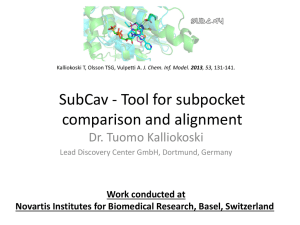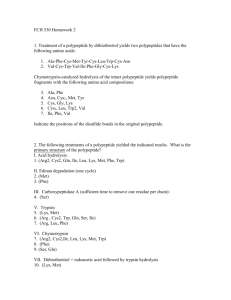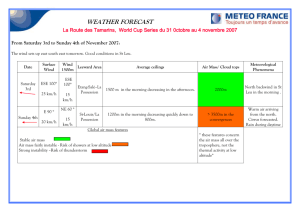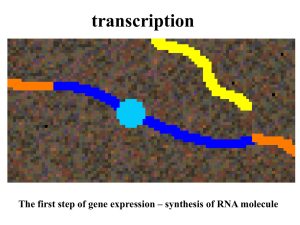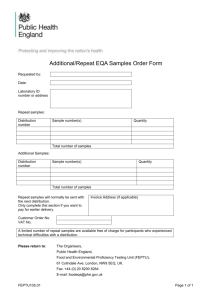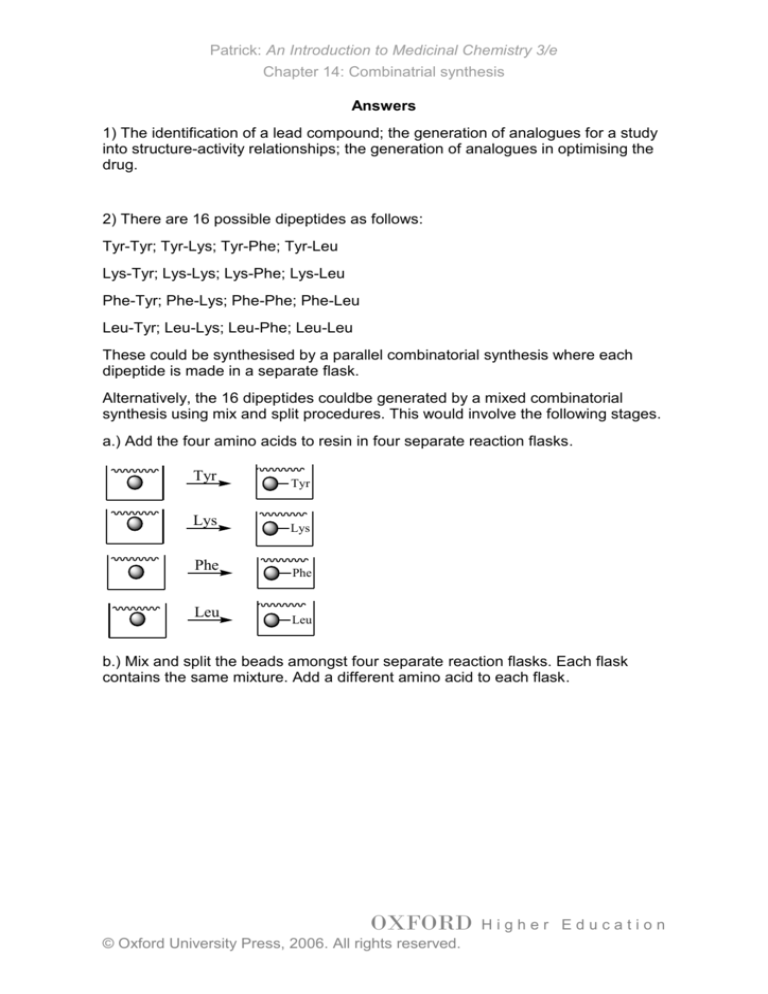
Patrick: An Introduction to Medicinal Chemistry 3/e
Chapter 14: Combinatrial synthesis
Answers
1) The identification of a lead compound; the generation of analogues for a study
into structure-activity relationships; the generation of analogues in optimising the
drug.
2) There are 16 possible dipeptides as follows:
Tyr-Tyr; Tyr-Lys; Tyr-Phe; Tyr-Leu
Lys-Tyr; Lys-Lys; Lys-Phe; Lys-Leu
Phe-Tyr; Phe-Lys; Phe-Phe; Phe-Leu
Leu-Tyr; Leu-Lys; Leu-Phe; Leu-Leu
These could be synthesised by a parallel combinatorial synthesis where each
dipeptide is made in a separate flask.
Alternatively, the 16 dipeptides couldbe generated by a mixed combinatorial
synthesis using mix and split procedures. This would involve the following stages.
a.) Add the four amino acids to resin in four separate reaction flasks.
Tyr
Lys
Phe
Leu
Tyr
Lys
Phe
Leu
b.) Mix and split the beads amongst four separate reaction flasks. Each flask
contains the same mixture. Add a different amino acid to each flask.
OXFORD
© Oxford University Press, 2006. All rights reserved.
Higher Education
Patrick: An Introduction to Medicinal Chemistry 3/e
Chapter 14: Combinatrial synthesis
Tyr
Lys
Tyr
Tyr
Phe
Phe
Leu
Tyr
Tyr
Lys
Lys
Phe
Leu
Mix
and split
Lys
Tyr
Phe
Phe
Leu
Tyr
Lys
Phe
Tyr
Phe
Phe
Leu
Tyr
Lys
Leu
Tyr
Phe
Phe
Leu
Tyr
Lys
Tyr
Tyr
Leu
Tyr
Lys
Lys
Lys
Lys
Leu
Lys
Phe
Lys
Phe
Phe
Leu
Phe
Leu
Lys
Leu
Leu
Leu
Leu
All 16 peptides are now present in four separate reaction flasks. No two flasks
contain the same dipeptide.
(Note that the peptide synthesis used would involve protection, coupling and
deprotection stages, see Fig. 14.2).
3) As stated in the previous question, normal procedures of peptide synthesis
would be employed, involving the protection, coupling and deprotection stages.
Additional protection strategies may be necessary for the amino acids tyrosine
and lysine since these contain functional groups on their side chains. Tyrosine
has a phenol group, while lysine has a primary amino group. Failure to protect
these functional groups may lead to alternative reactions.
4) In the following structures, it is assumed that the only variations allowed are the
groups R1 – R4.
OXFORD
© Oxford University Press, 2006. All rights reserved.
Higher Education
Patrick: An Introduction to Medicinal Chemistry 3/e
Chapter 14: Combinatrial synthesis
R1O
OR1
O
R1
O
O
R2
N
HN
R1
R2
O
HO OH
R4
R1
N
H
R
I
II
O
R2O
N
3
Ar
III
R3
IV
Structure I as illustrated is a poor scaffold since there is only limited variation
allowed. There are two locations where variation can occur but the groups are
identical. Moreover, the bottom half of the molecule is not varied at all. This is an
example of a tadpole scaffold. If a synthesis could be devised that could lead to
four different groups on all of the alcohol groups present in the structure, it would
be a far better scaffold. However, distinguishing between four alcohol groups
would not be easy.
Structure II is a good scaffold. The scaffold has a low molecular weight allowing
flexibility in the sort of substituents that can be introduced. Three different
substituents are allowed and they are not confined to one region of the molecule.
Structure III is not an ideal scaffold. Two different substituents are allowed at
either end, and there are a variety of substituent positions allowed. However, the
scaffold itself is planar which places quite a restriction on the conformational
space that can be explored round the molecule.
Structure IV is an excellent scaffold. It has a low molecular weight allowing a
variety of substituents to be added. There are five variable substituents located
right round the molecule, allowing an extensive search of the conformational
space around it.
R4
O
2
R
N
R1
R1
NH2
O
V
HO2C
N
O
O
R2
NHAr2
R2
NH
HO
R1
N
N
R3O
VI
O
O
NHAr1
VII
R4
R3
VIII
Structure V is not ideal. There are only two variable positions and this limits the
conformational space that can be explored. Moreover, the aromatic substituent
must be in the plane of the aromatic ring.
Structure VI is a good scaffold. The scaffold itself is small, and there are four
variable positions evenly distributed around the molecule, allowing an extensive
search of conformational space.
Structure VII is a poor scaffold. The molecule only has two variable positions.
Both of these have to be aromatic rings and so the molecular weight of the
molecule may be an issue.
Structure VIII is a good scaffold. The scaffold itself is small with a low molecular
weight, and there are four variable substituents distributed round the ring.
OXFORD
© Oxford University Press, 2006. All rights reserved.
Higher Education
Patrick: An Introduction to Medicinal Chemistry 3/e
Chapter 14: Combinatrial synthesis
5)
NH2
RCHBrCO2H
NH
R
O
Br
R'NH2
NH
R
O
NHR'
R"COCl
NH
R
O
NR'COR"
Bromoacid
(R)
Tag
Code Amine (R')
Tag Code Acid chloride Tag Code
(R")
B1
A
100
A1
D
100
C1
G
100
B2
B
010
A2
E
010
C2
H
010
B3
C
001
A3
F
001
C3
I
001
B4
AB
110
A4
DE
110
C4
GH
110
B5
AC
101
A5
DF
101
C5
GI
101
B6
BC
011
A6
EF
011
C6
HI
011
B7
ABC 111
A7
DEF 111
C7
GHI 111
6) The code in Fig. 14.22 is 101, 110, 111.
Based on the table above, this shows that the bromoacid used was B5, the amine
used was A4, and the acid chloride used was C7.
OXFORD
© Oxford University Press, 2006. All rights reserved.
Higher Education

